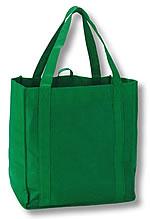What are the pros and cons of reusable grocery bags?
Plastic is threatening many aspects of life these days. With 4.8 to 12.7 million tons of plastic ending up in the world’s oceans each year, and 80% of that coming from the land and coastlines, there’s overwhelming concern about the plastics we use in our every day lives.
So what can you do personally to reduce your plastic use? One of the simplest ways to do so is to invest in reusable grocery bags.
There are many advantages to using reusable grocery bags, and they’re also much more environmentally friendly. Below is a list of comparable advantages to reusable grocery bags. While we definitely recommend investing in one, it’s important to weigh the pros and cons before making this lifestyle choice.
Advantages of Reusable Bags
Reusable
One of the biggest advantages to using reusable grocery bags is that they’re reusable! You can take them with you every time you go shopping. This means that you are one less person contributing to the 500 billion to 1 trillion plastic bags being used each year. And because you’ll be toting around your newest reusable bag, rather than all of the plastic bags you receive at the store, you’ll clear up space in your home or car where plastic bags used to reside, and reduce your waste overall.
Environmental Impact
Which brings us to the next advantage: environmental impact. Reusable bags are much better for the environment than single use plastic bags. Plastic grocery bags contribute to the death of one million birds, 100,000 turtles, and other sea animals that ingest plastic each year. And while the environmental cost of production for some reusable materials may be higher than single use HDPE plastics, that difference is counteracted by the amount of uses a reusable bag can have. In only 14 uses a durable polypropylene plastic bag becomes more environmentally friendly than an HDPE bag.
Money Saving
Reusable grocery bags also have the potential to save you money. Many grocery stores and even many cities and states are starting to charge for plastic bags. Rather than spending an extra couple bucks at the grocery store on disposable bags, reusable bags allow you to save money on each trip. You’re also reducing the amount of money your city spends on waste disposal. Each year, California alone spends $300 million cleaning up coastal litter.
Multipurpose
That compactable bag you bring with you to the grocery store can also carry your work supplies, your laundry, your beach gear, or even the contents of your purse. Reusable bags, unlike plastic grocery bags, are stronger, more durable, and can hold more things. There’s an infinite amount of purposes for your reusable shopping bag aside from the weekly trip to the grocery store. Use it for trips, for storage, or to support your favorite event or brand.
Personal and Creative
Speaking of supporting your favorite brand, reusable bags are also a convenient and useful way to express your creativity. Whether you design your own canvas bag, carry your favorite logo, or merely buy the most visually appealing bag to match your style, reusable bags are a very useful tool. You can even make your own reusable plastic bags, which are not only creative and personal, but also utilize old, used grocery bags in your home.
Disadvantages of Reusable Bags
Bacteria
Many people fail to think about what exactly they’re putting in their bags. We already stated that reusable bags are multipurpose, however many individuals don’t think about the buildup of bacteria from the multitude of things that get put in there. Research has proven that reusable bags eventually build up bacteria, such as coliform bacteria and even E. coli, without proper washing. However, their study also found that a simple hand or machine wash in between uses cleared up any residual bacteria.
Extra Baggage
Yes, single use grocery bags are just plain convenient. There’s no getting around the fact that remembering to bring your own bag to the grocery store is more tedious than just grabbing one while you’re there. However, the more you do, the more of a habit you create, and the easier it becomes. I don’t even think about the compact purple bag that’s stuffed in my purse anymore. The more you use it, the more convenient it becomes, and the less convenient it is to house tens of used plastic bags in your home.
Difficult to Dispose Of
Currently, many reusable bags are made of materials that are hard to dispose of, such as polyester, nylon, or polypropylene. While some recycling facilities do exist for these materials, they are few and far between. Fortunately, most reusable bags are made to last, so you won’t have to worry about disposing of them for some years. And hopefully while you’re getting your uses in, more and more recycling opportunities sprout up for these types of materials.
While yes, there are certain disadvantages to reusable bags, it seems there are far more advantages. Plastic pollution is quickly becoming one of the most pressing global, environmental, and structural problems to date. If we don’t act now, plastic will continue to infiltrate our oceans, waterways, soil, and food. Reusable bags may be lacking in convenience of single use plastic bags, but they are certainly one of the more simple problems we can stand to reduce merely through more conscious shopping.
Find A Solution
Second Life Tote: More sustainable on 1st use. Made from recycled plastic, this tote has the lowest breakeven point of any bag on the market. Check it out >>

The Daily – Pack Down: Goes with you anywhere – designed to be used daily – hundreds of times. Never forget your reusable again. Check it out >>
Produce Reusables: Don’t forget about your veggies. Plastic produce bags are so unnecessary. Replace them with a simple and reusable alternative. Check it out >>







